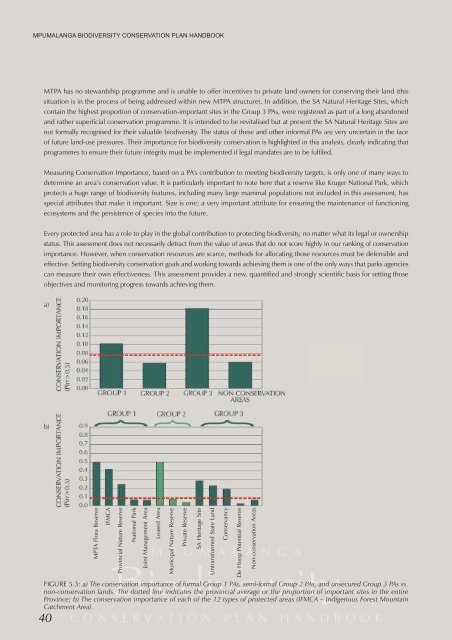Mpumalanga Biodiversity Conservation Plan Handbook - bgis-sanbi
Mpumalanga Biodiversity Conservation Plan Handbook - bgis-sanbi
Mpumalanga Biodiversity Conservation Plan Handbook - bgis-sanbi
You also want an ePaper? Increase the reach of your titles
YUMPU automatically turns print PDFs into web optimized ePapers that Google loves.
MPUMALANGA BIODIVERSITY CONSERVATION PLAN HANDBOOK<br />
MTPA has no stewardship programme and is unable to offer incentives to private land owners for conserving their land (this<br />
situation is in the process of being addressed within new MTPA structure). In addition, the SA Natural Heritage Sites, which<br />
contain the highest proportion of conservation-important sites in the Group 3 PAs, were registered as part of a long abandoned<br />
and rather superficial conservation programme. It is intended to be revitalised but at present the SA Natural Heritage Sites are<br />
not formally recognised for their valuable biodiversity. The status of these and other informal PAs are very uncertain in the face<br />
of future land-use pressures. Their importance for biodiversity conservation is highlighted in this analysis, clearly indicating that<br />
programmes to ensure their future integrity must be implemented if legal mandates are to be fulfiled.<br />
Measuring <strong>Conservation</strong> Importance, based on a PA’s contribution to meeting biodiversity targets, is only one of many ways to<br />
determine an area’s conservation value. It is particularly important to note here that a reserve like Kruger National Park, which<br />
protects a huge range of biodiversity features, including many large mammal populations not included in this assessment, has<br />
special attributes that make it important. Size is one; a very important attribute for ensuring the maintenance of functioning<br />
ecosystems and the persistence of species into the future.<br />
Every protected area has a role to play in the global contribution to protecting biodiversity, no matter what its legal or ownership<br />
status. This assessment does not necessarily detract from the value of areas that do not score highly in our ranking of conservation<br />
importance. However, when conservation resources are scarce, methods for allocating those resources must be defensible and<br />
effective. Setting biodiversity conservation goals and working towards achieving them is one of the only ways that parks agencies<br />
can measure their own effectiveness. This assessment provides a new, quantified and strongly scientific basis for setting those<br />
objectives and monitoring progress towards achieving them.<br />
a)<br />
b)<br />
40<br />
MPTA Flora Reserve<br />
IFMCA<br />
Provincial Nature Reserve<br />
National Park<br />
Joint Management Area<br />
Leased Area<br />
Municipal Nature Reserve<br />
Private Reserve<br />
SA Heritage Site<br />
Untransformed State Land<br />
Conservancy<br />
M P U M A L A N G A<br />
<strong>Biodiversity</strong><br />
FIGURE 5.3: a) The conservation importance of formal Group 1 PAs, semi-formal Group 2 PAs, and unsecured Group 3 PAs vs.<br />
non-conservation lands. The dotted line indicates the provincial average or the proportion of important sites in the entire<br />
Province; b) The conservation importance of each of the 12 types of protected areas (IFMCA – Indigenous Forest Mountain<br />
Catchment Area).<br />
CONSERVATION PLAN HANDBOOK<br />
De Hoop Potential Reserve<br />
Non-conservation Areas

















